| Sesame Street | |
| Premiere | November 10, 1969 (0001) |
| Finale | May 8, 1970 (0130) |
| Episodes | 130 |

Sesame Street Show Open Season 1
Season 1 opening.
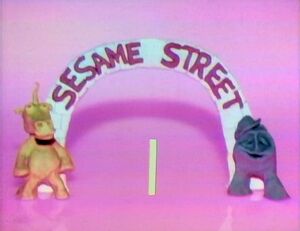
Season 1 title card.
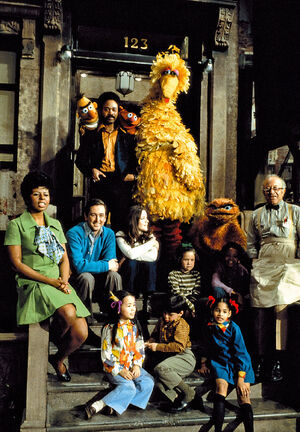
The season 1 cast.
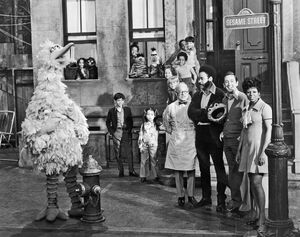
The original cast of Sesame Street.

Ernie, Bert, Betty Lou, Roosevelt Franklin, Gordon and Susan.
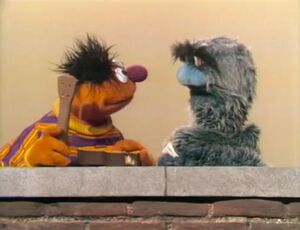
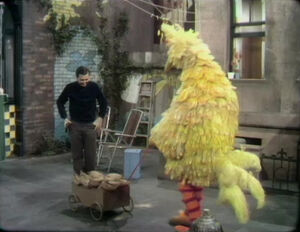
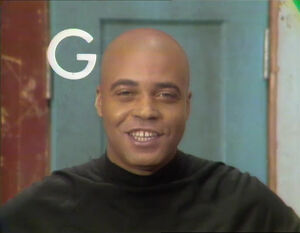
James Earl Jones on Sesame Street.
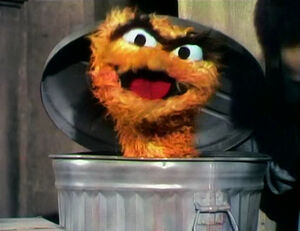
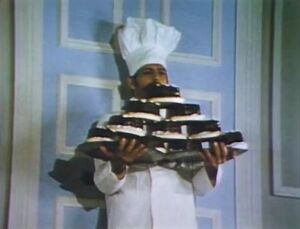
The baker in Numerosity.
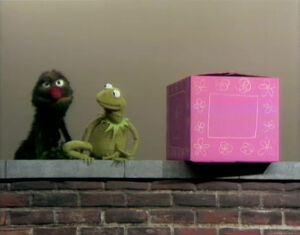
Kermit the Frog and early Grover.
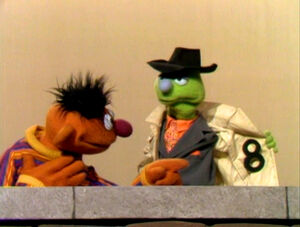
Ernie and the Salesman.
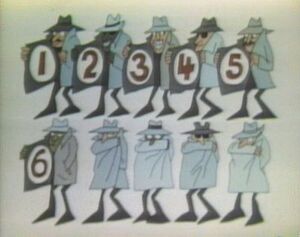
Six spies in Jazz Numbers.
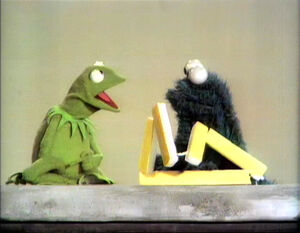
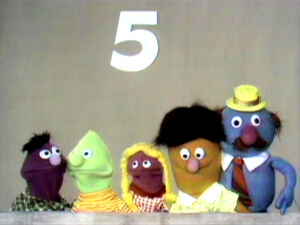
The Anything Muppets of Sesame Street.
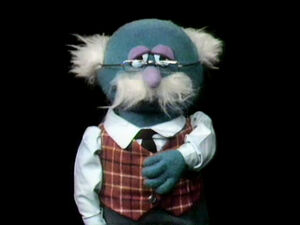
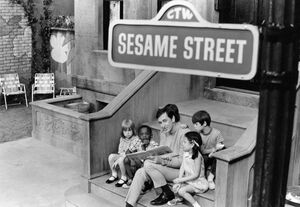
Bob reads a book to the kids on the 123 Sesame Street stoop, a recurring segment in the season.
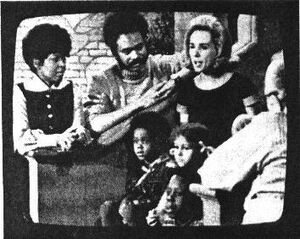
Ethel Kennedy on Sesame Street.
After five test shows and years of preparation, Sesame Street premiered on NET (National Educational Television, a precursor of PBS) on November 10, 1969.
Characters
During this first season, Oscar the Grouch and Big Bird were the only Muppets to appear regularly in Street scenes, while most of the other Muppets debuted in separate segments. Many of the Muppet characters had designs and/or character traits that would be changed or dropped later on. Big Bird had a much more naïve voice and a smaller head with fewer feathers, and was written as a sort of dopey adult character. Oscar, who would still retain much of his grouchy demeanor almost 40 years later, had orange fur. Monsters, who would become core characters by the second season, had fierce teeth, often destroyed anything in their path, and didn't have consistent names.
Bob, Mr. Hooper, Gordon, and Susan were the original human cast members. With the exception of Mr. Hooper, who died in 1982, the other original characters are still with the series as of the 2010s, making them some of the longest continually-running non-soap opera characters in American entertainment. Like the Muppets, the human characters would change over time. Bob, originally a shop teacher, would later teach music, and by the end of the first season Susan would become a nurse. The season also featured live-action segments starring Buddy and Jim, a human comedy duo that failed at such tasks as hanging a picture and making a sandwich. Jennie also made occasional appearances.
Format
Sesame Street's format as established in 1969 would remain virtually unchanged for decades; live-action street scenes would alternate with Muppet comedy skits, musical numbers and short film segments, all known collectively as "inserts". Many of the Muppet scenes and films were created so that they could be replayed over and over (at least one segment would be repeated within any given episode); some of the segments made in 1969 would continue to be rebroadcast into the 1990s. (Many of these pieces are available for viewing at sesamestreet.org, and continue to be shown in various international co-productions.)
The original episodes had a much more literal, almost lecture-like tone to the Street scenes, closer in style to its original contemporaries like Mister Rogers' Neighborhood or Captain Kangaroo. With time, the Street-scenes became more natural with a definite plot thrust, with less breaking of the fourth wall. For example, in the first episode, Ernie once addresses the audience as those in "TV land".
While the Muppets would eventually become the biggest stars of the show, they did not appear as frequently as the cast. Cartoon segments aired more frequently than Muppet segments, and as such, some of the original illustrated promotional material featured the cast and Muppets interacting with animated characters, who also appeared in advertisements of the show. Animated segments and live-action inserts featured in the season included Alice Braithwaite Goodyshoes, Jazz Numbers, Speech Balloons, Alphabet Bates and Numerosity, most of which continued to air many years later.
The season introduced many original songs that have gone on to become beloved Sesame Street classics, including "Rubber Duckie", "I Love Trash", "Bein' Green", "The People in Your Neighborhood" and "One of These Things". While all of those songs would have multiple performances on the show over the years, the last two would have many different versions during this season.
During the first season, many segments had some sort of connection with each other. It would be common for characters in the street scenes to introduce the next segments, various Muppet inserts would directly lead into the next film or cartoon, celebrities would appear in sort tag sequences commenting on the previous segments, and some Muppet inserts would have them commenting on the previous segments. Some episodes during this season would end with live animals appearing on the street set. Many episodes also had segments where one of the adults would read an existing children's book.
Curriculum
In 1968, the Children's Television Workshop established the original educational concepts that would prepare children for school. Over time these would be expanded into larger fields (such as women's career awareness, medical issues, and science and space). The original topics that were focused on during the first season included:
- recognition of the 26 letters of the alphabet (often in the form of short cartoons like the Speech Balloon series)
- numbers from one to ten (both forwards and backwards)
- shapes: circles, rectangles, triangles, and squares
- putting items in the right order, reasoning, and problem-solving
- classification (illustrated by the song "One of These Things")
- relational concepts (including "Near and Far", "Big and Little", and "First and Last")
- perceptual and auditory discrimination
- self: parts of the body, coordinated movement, emotions, differing perspectives, and self-esteem (as illustrated by Kermit the Frog's "Bein' Green song)
- roles: members of the family, and jobs
- cooperation and fair play
- the natural environment (often demonstrated in animal films) and the man-made environment[1]
Episodes
Episodes 0001 - 0130 (130 episodes)
- Episode 0001 -- Premiere episode; Gordon introduces Sally to Sesame Street
- Episode 0002 -- Oscar decides to leave Sesame Street
- Episode 0003 -- Big Bird makes a sweater for Susan
- Episode 0004 -- Gordon, Susan and Bob run Hooper's Store for the day
- Episode 0005 -- Oscar gets wet in a rainstorm
- Episode 0006 -- Block party on Sesame Street
- Episode 0007 -- Oscar's birthday / Mr. Hooper counts jelly beans
- Episode 0008 -- B treasure hunt; Ernie erases Cookie Monster.
- Episode 0009 -- Lost cat on Sesame Street
- Episode 0010
- Episode 0011
- Episode 0012
- Episode 0013 -- Big Bird "helps" Mr. Hooper
- Episode 0014
- Episode 0015
- Episode 0016
- Episode 0017 -- Oscar's hiccups
- Episode 0018 -- Big Bird's hide-and-seek; Mr. Hooper's rocket launchers
- Episode 0019
- Episode 0020 -- Oscar cleans house
- Episode 0021 -- Big Bird discovers balloons; Susan in the kitchen
- Episode 0022 -- The birthday party
- Episode 0023
- Episode 0024 -- What's wrong with Big Bird?
- Episode 0025
- Episode 0026
- Episode 0027 -- Tony Saletan visits
- Episode 0028
- Episode 0029
- Episode 0030 -- Granny Bird visits
- Episode 0031
- Episode 0032 -- Shapes on the clothesline
- Episode 0033 -- Michael Cooney visits
- Episode 0034 -- A windy day
- Episode 0035
- Episode 0036 -- Mr. Glopper sets up his hot dog cart on the street
- Episode 0037 -- Oscar's missing trash can lid
- Episode 0038 -- Gordon's errands
- Episode 0039
- Episode 0040
- Episode 0041 -- Mr. Hooper's newspaper machine
- Episode 0042 -- Oscar takes a trip
- Episode 0043 -- The cast introduces L, Q and Y; Kermit explains big and small.
- Episode 0044 -- Rufus visits / Oscar's boarder
- Episode 0045
- Episode 0046 -- Big Top Big Bird
- Episode 0047
- Episode 0048 -- A visit from Pete Seeger
- Episode 0049
- Episode 0050
- Episode 0051 -- The art contest
- Episode 0052
- Episode 0053
- Episode 0054 -- Oscar bakes a cake; Mr. Hooper invents a 10 machine.
- Episode 0055
- Episode 0056 -- Mr. Hooper bakes Oscar a baked bean sundae
- Episode 0057
- Episode 0058
- Episode 0059
- Episode 0060 -- Up and down!
- Episode 0061
- Episode 0062
- Episode 0063
- Episode 0064
- Episode 0065
- Episode 0066
- Episode 0067
- Episode 0068
- Episode 0069
- Episode 0070 -- Oscar and the Groovin' Grouches / Susan's plant
- Episode 0071
- Episode 0072
- Episode 0073
- Episode 0074
- Episode 0075
- Episode 0076
- Episode 0077 -- Oscar watches the Grouch Bowl/Mr. Hooper's missing glasses
- Episode 0078
- Episode 0079
- Episode 0080
- Episode 0081
- Episode 0082
- Episode 0083 -- Big Bird moves birdseed to his nest.
- Episode 0084
- Episode 0085
- Episode 0086
- Episode 0087
- Episode 0088
- Episode 0089
- Episode 0090
- Episode 0091
- Episode 0092
- Episode 0093
- Episode 0094
- Episode 0095
- Episode 0096
- Episode 0097
- Episode 0098
- Episode 0099
- Episode 0100
- Episode 0101
- Episode 0102
- Episode 0103
- Episode 0104
- Episode 0105
- Episode 0106
- Episode 0107
- Episode 0108
- Episode 0109
- Episode 0110
- Episode 0111
- Episode 0112
- Episode 0113
- Episode 0114
- Episode 0115 -- Gordon, Susan, and the kids go on an imaginary car ride
- Episode 0116
- Episode 0117
- Episode 0118
- Episode 0119
- Episode 0120
- Episode 0121
- Episode 0122
- Episode 0123 -- Big Bird draws lowercase and uppercase R's
- Episode 0124
- Episode 0125
- Episode 0126
- Episode 0127
- Episode 0128
- Episode 0129 -- Oscar hosts the show
- Episode 0130
Cast
- Caroll Spinney, Frank Oz, Jim Henson (Uncredited: Danny Seagren, Caroly Wilcox)
Muppet Characters
- Anything Muppets, Baskerville the Hound, Beautiful Day Monster, Bert, Betty Lou, Big Bird, Big V, Cookie Monster, Ernie, Fred, Fred's son, Flute-Snatcher, Grover, Guy Smiley, Hippie, Kermit the Frog, Little Bird, Lefty the Salesman, Oscar the Grouch, Professor Hastings, Roosevelt Franklin, Roosevelt Franklin's Mother, Scudge, the Snerfs, Snerk, Splurge, Thudge, Tony
- Batman and Robin, Carol Burnett, Michael Cooney, Ruby Dee, Mahalia Jackson, James Earl Jones, Ethel Kennedy, B.B. King, Burt Lancaster, Don McLean, Listen My Brother, Odetta, Pat Paulsen, Lou Rawls, Jackie Robinson, Rowlf the Dog, Pete Seeger, Superman
Credits

Season 1 credit crawl
credit crawl
- Executive Producer: David D. Connell
- Producers: Samuel Y. Gibbon Jr., Jon Stone, Matt Robinson, Lutrelle Horne
- Director: Neil Smith
- Writers: Jon Stone, Jeffrey Moss, Bruce Hart, Carol Hart, Ray Sipherd, Jerry Juhl, Dan Wilcox
- Art Director: Charles Rosen
- Costume Designer: Doreen Ackerman
- Music Director: Joe Raposo
- Music Coordinator: Danny Epstein
- Associate Producer: Lutrelle Horne
- Director of Research: Edward L. Palmer, Ph.D.
- Chairman, Board of Advisors: Gerald S. Lesser, Ph.D.
- Director of Operations: Ronald L. Weaver
- Production Supervisor: Lew Barlow
- Supervising Film Editor: Dorothy Tod
- Film Editor: M.M. Murphy
- Graphic Artist: Elaine Selig
- Special Assistants: Barbara Demaray, Jane O'Connor
- Assistant to the Producer: Dulcy Singer
- Production Assistants: Emily Squires, Mary Jane Behrens, Lisa Simon, Mary Bauer
- Associate Director: Jan S. Rifkinson
- Technical Director: Bob Alexander
- Lighting Director: Mike Mannes
- Audio: Mike Shoskes, Arnie Rosenzweig
- Video: Bob Squittieri, Gridley Quihuis
- Sound Effects: Ralph Curtiss, Dick Maitland[2]
- Stage Manager: Chet O'Brien
- Property Coordinator: Nat Mongioi
- Unit Managers: Bernie Jones, Tony Marshall
- Hair Stylist: Mickey Lawrence
- Make-Up: Phyllis Grens
- Video Tape Editors: Joe O'Dowd, John Hutchison, Vincent Sims, Hal McKeon
- Camera: Frank Biondo, Richard King[3] (uncredited)
- Recorded by Tele-Tape at Second Stage
Sources
- ↑ Truglio and Fisch. G is for Growing. p. 31
- ↑ Sesame Street: A Celebration - 40 Years of Life on the Street, page 229
- ↑ Spinney, Caroll The Wisdom of Big Bird, p. 105
| Previous season: | Next season: |
| (first) | Season 2 (1970-1971) |
